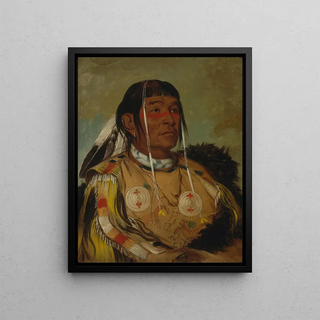Art print | Sha-C-Pay, the Six Chief of the Plains Ojibwe - George Catlin


View from behind

Frame (optional)
Reproduction Sha-C-Pay, the Six Chief of the Plains Ojibwés - George Catlin – Captivating Introduction
In the fascinating world of American art, the artwork "Sha-C-Pay, the Six Chief of the Plains Ojibwés" by George Catlin stands out for its emotional depth and commitment to representing indigenous peoples. This piece, which captures the essence of Ojibwée culture, transports us to the heart of the American prairies, offering a valuable glimpse into the life and traditions of a often misunderstood people. Through Catlin's perspective, the viewer is invited to contemplate not only the portrait of a chief but also the soul of a community, its struggles, and its hopes. The art print of this iconic work allows appreciation of the richness of this cultural heritage, while also inspiring reflection on the place of indigenous peoples in American history.
Style and uniqueness of the work
Catlin's work is characterized by a unique style that combines realism and idealization. In "Sha-C-Pay, the Six Chief of the Plains Ojibwés," the artist manages to capture not only the physical features of the chief but also the intensity of his character and the majesty of his role within his people. The vivid colors, meticulous details of traditional clothing, and the profound expression on the face give this portrait an almost lifelike dimension. Catlin skillfully uses light and shadow, creating an atmosphere that evokes the dignity and strength of the Ojibwés. The work fits within a portrait tradition that goes beyond simple representation, seeking to establish an emotional connection between the subject and the viewer, while preserving the authenticity of the culture depicted.
The artist and his influence
George Catlin, 19th-century painter and ethnographer, dedicated a significant part of his career to documenting Native American cultures through his works. Traveling across the United States, he had the opportunity to meet various indigenous peoples, including the Ojibwés, and to represent them with sincere respect and admiration. Catlin is often considered one of the first artists to highlight the cultural richness of the Native Americans.

Matte finish

View from behind

Frame (optional)
Reproduction Sha-C-Pay, the Six Chief of the Plains Ojibwés - George Catlin – Captivating Introduction
In the fascinating world of American art, the artwork "Sha-C-Pay, the Six Chief of the Plains Ojibwés" by George Catlin stands out for its emotional depth and commitment to representing indigenous peoples. This piece, which captures the essence of Ojibwée culture, transports us to the heart of the American prairies, offering a valuable glimpse into the life and traditions of a often misunderstood people. Through Catlin's perspective, the viewer is invited to contemplate not only the portrait of a chief but also the soul of a community, its struggles, and its hopes. The art print of this iconic work allows appreciation of the richness of this cultural heritage, while also inspiring reflection on the place of indigenous peoples in American history.
Style and uniqueness of the work
Catlin's work is characterized by a unique style that combines realism and idealization. In "Sha-C-Pay, the Six Chief of the Plains Ojibwés," the artist manages to capture not only the physical features of the chief but also the intensity of his character and the majesty of his role within his people. The vivid colors, meticulous details of traditional clothing, and the profound expression on the face give this portrait an almost lifelike dimension. Catlin skillfully uses light and shadow, creating an atmosphere that evokes the dignity and strength of the Ojibwés. The work fits within a portrait tradition that goes beyond simple representation, seeking to establish an emotional connection between the subject and the viewer, while preserving the authenticity of the culture depicted.
The artist and his influence
George Catlin, 19th-century painter and ethnographer, dedicated a significant part of his career to documenting Native American cultures through his works. Traveling across the United States, he had the opportunity to meet various indigenous peoples, including the Ojibwés, and to represent them with sincere respect and admiration. Catlin is often considered one of the first artists to highlight the cultural richness of the Native Americans.






